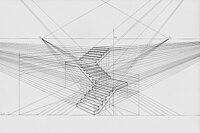
Photo from wikipedia
The real visual attention areas of students during the learning process are vital data. They represent the students’ visual concentration and provide strong support for the analysis of learning effects.… Click to show full abstract
The real visual attention areas of students during the learning process are vital data. They represent the students’ visual concentration and provide strong support for the analysis of learning effects. It is necessary to use professional equipment to collect the visual attention areas of students on a screen but this equipment is expensive, so it cannot be solely depended upon. A binocular camera can directly obtain the depth information under static conditions; thus, detected pupil and iris sizes do not change as the user-to-screen distance changes. Robust pupil detection is an important prerequisite for gaze detection in a real-world setting. Hence, an accurate algorithm to calculate the position of pupils and the size of irises under natural light is proposed in this paper. It is based on the positive and negative oblique projection of relative linear density. The MPIIGaze dataset was used to test the algorithm, and the experimental results show that the algorithm is resistant to changes in illumination and the presence of glasses. Moreover, compared with a system based on a monocular camera, the error in the distance between label points and gaze location is decreased by 5 pixels and dispersion is decreased by 3 pixels. Finally, the line of sight is concentrated and the dispersion is low. With the ‘user-screen’ distance between 60cm and 80cm, the accuracy can reach up to 1.5° to 2.2°.
Journal Title: IEEE Access
Year Published: 2020
Link to full text (if available)
Share on Social Media: Sign Up to like & get
recommendations!